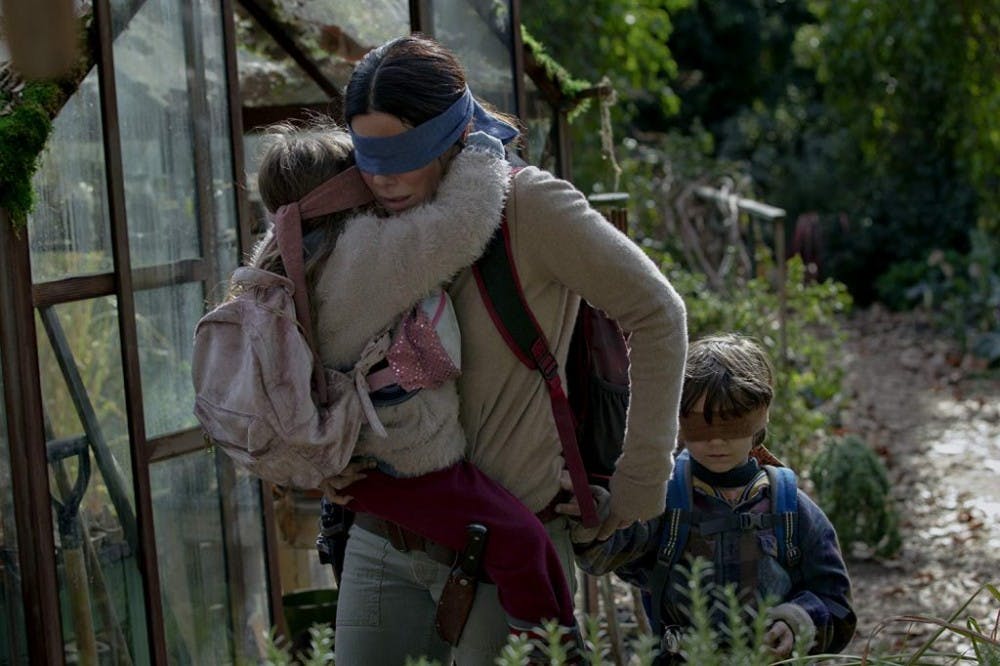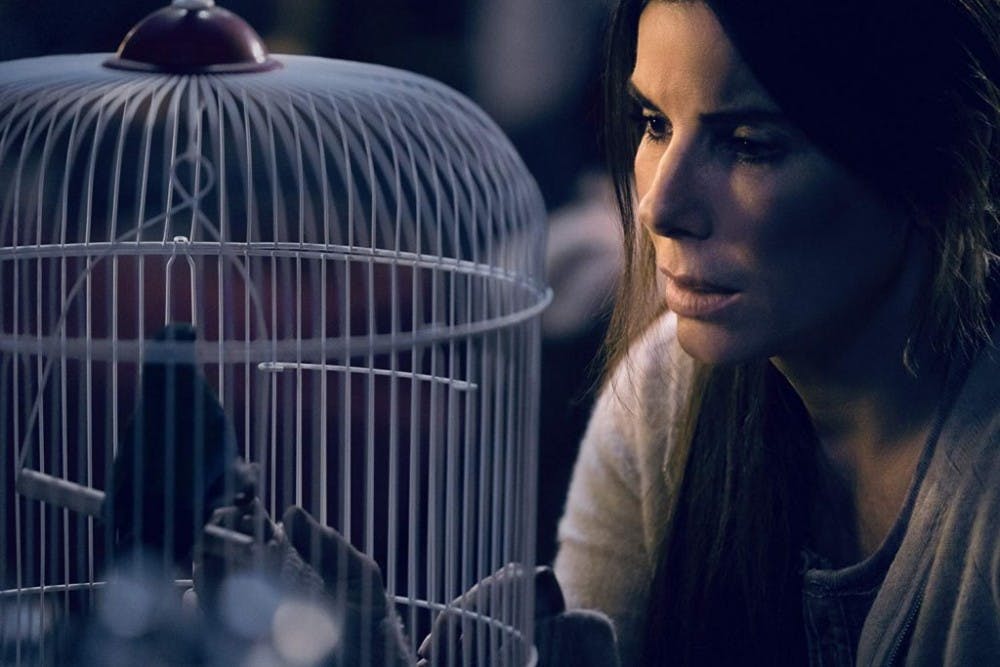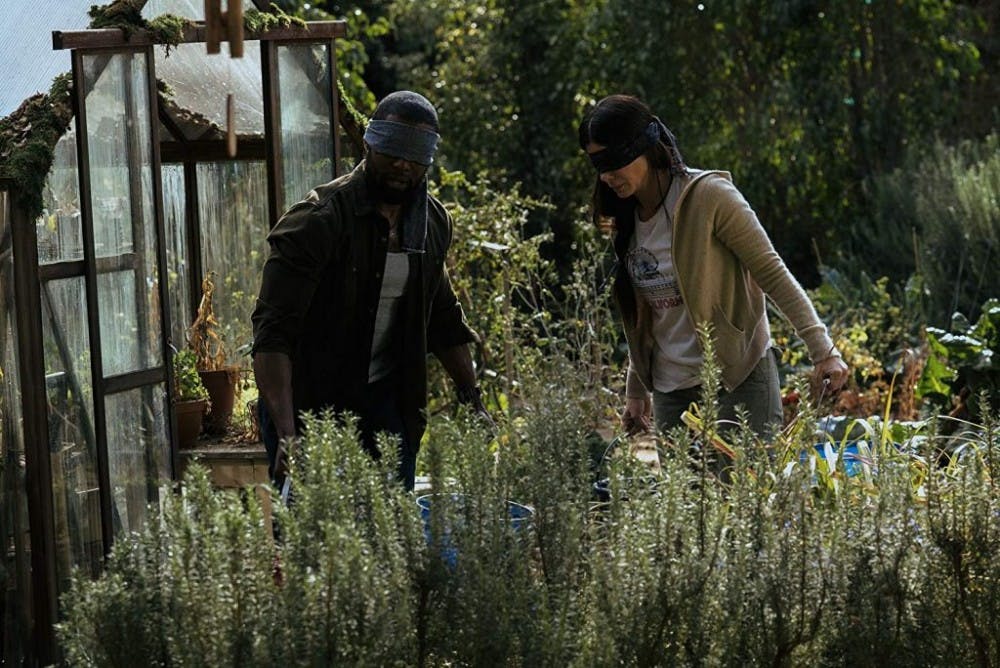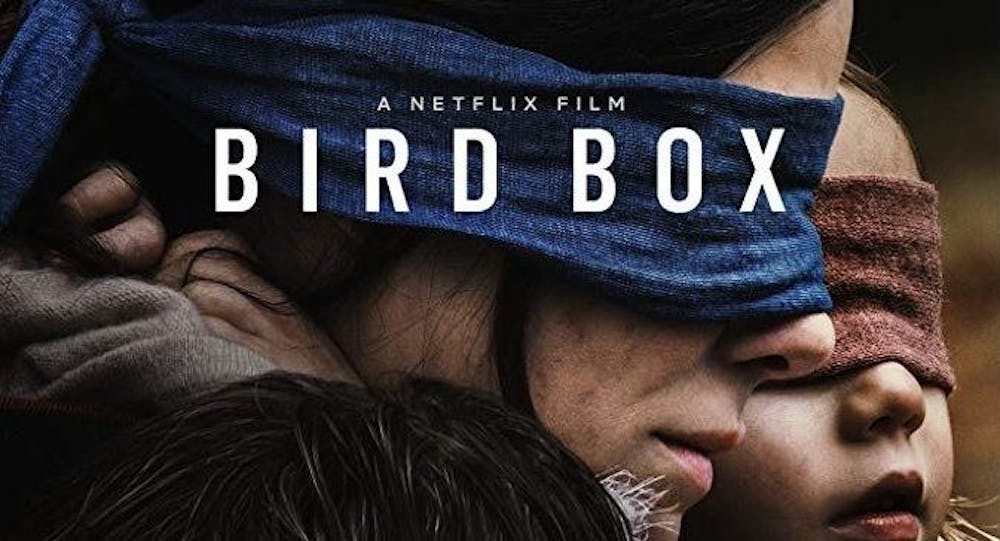Released on December 21st, Bird Box began streaming on Netflix, and according to the company’s Twitter account, the film has already been watched by over 45 million Netflix accounts in its first week, making it the most watched original Netflix film.
News of the Netflix original spread fast, and almost immediately a storm of memes referencing the film infiltrated the internet. I think it’s safe to say at this point if you haven’t seen Bird Box, you’ve probably seen the memes referencing it.
But is the film worth all the hype, or is it just another meme-able piece of content that will disappear in the next few weeks? Personally, I’m banking on the latter.
One part The Happening and one part I am Legend
Malorie Hayes (Sandra Bullock), an expectant mother, finds herself navigating an apocalypse as humanity is slowly driven insane by invisible entities causing those who look at them to kill themselves. Malorie and a group of survivors quickly learn they can avoid being inflicted by keeping their eyes covered while outside and covering all windows in their safe house.
The film begins with Malorie navigating a river, blindfolded, with her two children, but the bulk of the film is dedicated to relaying the events building up to the fipm’s opening. This means that the film jumps between the past and Malorie currently trying to escape to safety on the river. This narrative framing is a tool used to indicate a passage of time while Malorie is rowing with her children.

Image from IMDb
Considering that this voyage takes place over the course of about two days, it’s an understandable choice so we don’t have to sit and watch the characters sitting quietly on the river, but I can’t help but feel that the film feels a bit clunky as a result. The segments of the film set in the present often interrupt portions of the flashback, disrupting the film’s flow. This is especially apparent when one scene set in the present is showed twice, most likely for dramatic emphasis. The problem is not enough time had passed between flashback and the present, so the scene comes off as misplaced and repetitive. Ultimately the narrative framing effectively takes me out of the film and breaks any immersion I may have felt.
Additionally, I often found myself unable to really empathize with any of the characters. Not because I disliked them, but because they just aren’t terribly expressive. When chaos initially begins to break out in typical apocalypse-film fashion, the masses understandably panick. Cars are flipping over, explosions are going off in the distance, people knocking each other down, these are all expected reactions in an emergency situation. However, once Malorie finds refuge no one in the group seems terribly concerned. Don’t get me wrong. They say they’re concerned, but everyone is honestly really calm. Like, casual conversations are being held calm. This carries on later in the film as tensions escalate and stakes rise, so it’s a bit hard to take the threat terribly seriously.
This isn’t to say the overall acting is bad. In fact I would classify almost everyone’s performance as passable. Not good, but not terrible either. Sandra Bullock’s performance ranges from good to fine. Tom, one of the survivors played by Trevante Rhodes, best known from his role as Chiron in Moonlight, does a decent job even though the character isn’t written to be exceptionally compelling. The rest of the survivors all range from forgettable to just bland. Familiar faces like BD Wong and John Malkovich are obviously just there so the film could attach a few celebrity names to the credits. Another side character, Charlie (Lil Re Howery), is notable because of the strangeness of his character. To be frank he’s really the only one I’m likely to remember positively a few months from now, so kudos to him.
Kids so bland they don’t have names

Image from IMDb
I also want to discuss the use of children, or more accurately, lifeless props in this film. One of my biggest pet peeves is when a character is defined by their children and children are written to be extensions of the protagonist and nothing else. I don’t understand why having children means that your main character can’t be interesting themselves. Is there a law I don’t know about?
This isn’t to say that characters in films can’t effectively be influenced, motivated or impacted by children; it’s just that in this film it isn’t done well. The issue of parental bonding, something that was strongly alluded to at the beginning of the film, is dropped, and instead Bullock’s character seems to automatically fill the role of the protector without issue, making for a standard survival hero that also happens to be a parent.
The children themselves are completely devoid of charm or character. Between the two of them they maybe have 15 words in the film. They hardly act like children. In fact, they hardly do anything. They were written to serve as a prop for the protagonist.
Room a horror film released in 2015, is an excellent example of how to not only utilize children in films but also how to showcase complicated relationships between parents and children onscreen. Bird Box is hardly the only film guilty of poorly utilized children characters, but considering that the stakes of the film stem from protecting the children, it is unacceptable just how disposable they seem. Room demonstrates that children don’t have to be just props: They can be their own characters and have meaningful relationships with parental figures. Bird Box on the other hand reinforces lazy script writing that relies purely on audiences feeling connected because the character is some innocent child.
The uncomfortable handling of mental illness
Bird Box features entities that prey on their victims’ minds, driving them to hear voices and commit suicide. There is a clear parallel being made to mental illness, and that makes the film a bit uncomfortable.
This could be an interesting concept if executed correctly, but Bird Box fails to really say anything meaningful in its symbolism. Mental illness is bad… and what? There is no nuance, no thought. Instead mental illness is just a scary monster that makes you kill yourself if you look at it. That’s… not a good picture to paint for audiences.

Image from IMDb
Is the film saying looking mental illness in the eye is a death sentence? Is it saying we should cover our eyes and pretend it doesn’t exist? I can’t say for certain, because the film doesn’t provide any answers. This lack of clarity leaves the film open for negative interpretation.
This is further complicated when a character states that those who are criminally insane can look around freely without being driven to suicide. Literally people defined simply as criminally insane are walking around the film attacking the other survivors and calling the entities beautiful. In fact, they aid in spreading it by forcing other survivors to go outside and open their eyes, often by force.
This naturally raises the question: What constitutes criminally insane? Not everyone is just diagnosed as a psychopath and thrown into a cell, so who all falls into this category?
Even more confusing is the brief inclusion of a character that is described as being in and out of prison and “a bit crazy,” and they are also allied with the people who want to infect everyone else. The film correlates mental illness and criminality with working to kill others, making every character called crazy into a villain. By this vague definition, anyone with common mental disorders like depression or anxiety could easily fall into this crowd.
Look, suicide and mental illness aren’t taboo subjects that shouldn’t be explored in film, but Bird Box is so tone deaf and confused in both presentation and lack of any clear intended meaning that it comes across as ignorant at best and potentially harmful at worst.
Isn’t this just a copy of A Quiet Place but with blindfolds?

Image from IMDb
When I first heard about Bird Box my first thought was something along the lines of “Oh, so it’s A Quiet Place but instead of being unable to speak, you can’t use your sight.” Well yes, but it isn’t a exactly a copy. Bird Box is actually based off a book of the same name that released in 2013, but even so, I think comparing A Quiet Place and Bird Box is inevitable: Both are set in a post-apocalyptic setting, featuring a family being chased by monsters. The monsters in both films are closely tied to senses. Both films utilize pregnancy and giving birth as a prominent narrative device, and children become the primary concern of the protagonist in both films.
These similarities don’t necessarily pose a problem, but they are also something I can’t help but notice. Filming for A Quiet Place began in May 2017, while filming for Bird Box began in October 2017 after Netflix acquired the rights to the book of that same year. After the hype of A Quiet Place, it seems like Netflix found their own source material and followed suit. This is definitely a more cynical view; I mean, obviously the film can still be good even if it’s trying to follow a trend. The problem is that it’s a completely average film, and the creators knew that it didn’t have to be good because people would see it for the premise anyway.
I can’t help but watch Bird Box and feel let down. The film is well-shot. And there are some fun moments here and there, but the gimmick of being unable to see just isn’t enough to make the film impactful, especially when the film skips around so often and doesn’t really show us how the characters have learned to adapt and survive. Take away the gimmick, and this film is basically any other run of the mill post apocalypse film. If you like watching groups of survivors make bad decisions and bicker, then you’re in for a treat.
After the initial hype calms down, the film will likely fade into obscurity. Bird Box isn’t good. It isn’t bad. It’s painfully average. If you’ve seen other similar films, or even shows like The Walking Dead, you’ll likely be bored. If this is your first foray into the genre, hopefully you can get more enjoyment out of the film than I did.
Featured Image: IMDb
Images: IMDb
For more entertainment related content, visit us at Byte BSU!



















